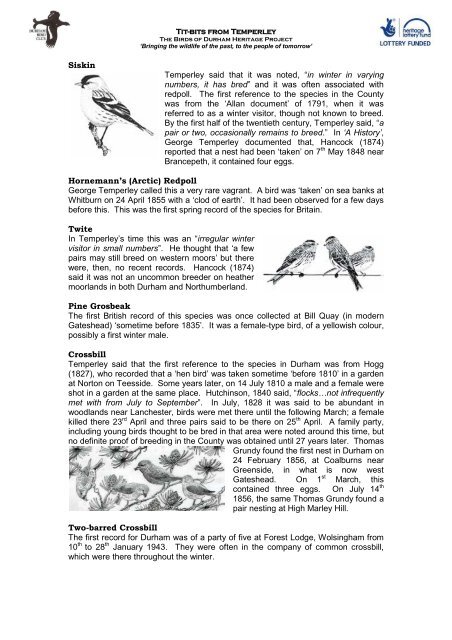'Tit-bits from Temperley' - Durham Bird Club
'Tit-bits from Temperley' - Durham Bird Club
'Tit-bits from Temperley' - Durham Bird Club
You also want an ePaper? Increase the reach of your titles
YUMPU automatically turns print PDFs into web optimized ePapers that Google loves.
Siskin<br />
Tit-<strong>bits</strong> <strong>from</strong> Temperley<br />
The <strong>Bird</strong>s of <strong>Durham</strong> Heritage Project<br />
‘Bringing the wildlife of the past, to the people of tomorrow’<br />
Temperley said that it was noted, “in winter in varying<br />
numbers, it has bred” and it was often associated with<br />
redpoll. The first reference to the species in the County<br />
was <strong>from</strong> the „Allan document‟ of 1791, when it was<br />
referred to as a winter visitor, though not known to breed.<br />
By the first half of the twentieth century, Temperley said, “a<br />
pair or two, occasionally remains to breed.” In ‘A History’,<br />
George Temperley documented that, Hancock (1874)<br />
reported that a nest had been „taken‟ on 7 th May 1848 near<br />
Brancepeth, it contained four eggs.<br />
Hornemann’s (Arctic) Redpoll<br />
George Temperley called this a very rare vagrant. A bird was „taken‟ on sea banks at<br />
Whitburn on 24 April 1855 with a „clod of earth‟. It had been observed for a few days<br />
before this. This was the first spring record of the species for Britain.<br />
Twite<br />
In Temperley‟s time this was an “irregular winter<br />
visitor in small numbers”. He thought that „a few<br />
pairs may still breed on western moors‟ but there<br />
were, then, no recent records. Hancock (1874)<br />
said it was not an uncommon breeder on heather<br />
moorlands in both <strong>Durham</strong> and Northumberland.<br />
Pine Grosbeak<br />
The first British record of this species was once collected at Bill Quay (in modern<br />
Gateshead) „sometime before 1835‟. It was a female-type bird, of a yellowish colour,<br />
possibly a first winter male.<br />
Crossbill<br />
Temperley said that the first reference to the species in <strong>Durham</strong> was <strong>from</strong> Hogg<br />
(1827), who recorded that a „hen bird‟ was taken sometime „before 1810‟ in a garden<br />
at Norton on Teesside. Some years later, on 14 July 1810 a male and a female were<br />
shot in a garden at the same place. Hutchinson, 1840 said, “flocks…not infrequently<br />
met with <strong>from</strong> July to September”. In July, 1828 it was said to be abundant in<br />
woodlands near Lanchester, birds were met there until the following March; a female<br />
killed there 23 rd April and three pairs said to be there on 25 th April. A family party,<br />
including young birds thought to be bred in that area were noted around this time, but<br />
no definite proof of breeding in the County was obtained until 27 years later. Thomas<br />
Grundy found the first nest in <strong>Durham</strong> on<br />
24 February 1856, at Coalburns near<br />
Greenside, in what is now west<br />
Gateshead. On 1 st March, this<br />
contained three eggs. On July 14 th<br />
1856, the same Thomas Grundy found a<br />
pair nesting at High Marley Hill.<br />
Two-barred Crossbill<br />
The first record for <strong>Durham</strong> was of a party of five at Forest Lodge, Wolsingham <strong>from</strong><br />
10 th to 28 th January 1943. They were often in the company of common crossbill,<br />
which were there throughout the winter.


